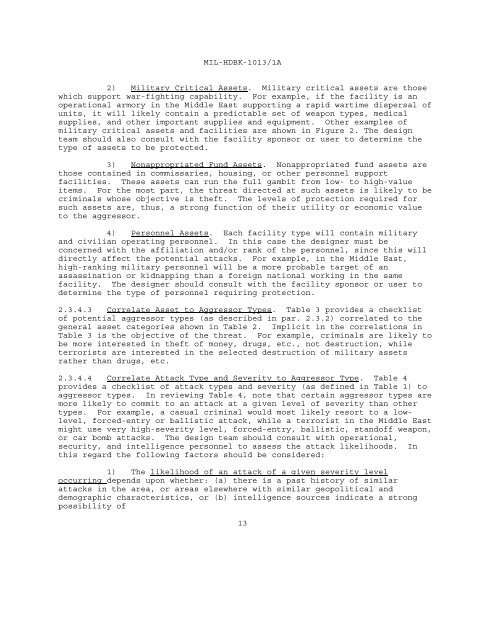MIL-HDBK-1013/1A Design Guidelines for Physical Security of ...
MIL-HDBK-1013/1A Design Guidelines for Physical Security of ...
MIL-HDBK-1013/1A Design Guidelines for Physical Security of ...
Create successful ePaper yourself
Turn your PDF publications into a flip-book with our unique Google optimized e-Paper software.
<strong>MIL</strong>-<strong>HDBK</strong>-<strong>1013</strong>/<strong>1A</strong><br />
2) Military Critical Assets. Military critical assets are those<br />
which support war-fighting capability. For example, if the facility is an<br />
operational armory in the Middle East supporting a rapid wartime dispersal <strong>of</strong><br />
units, it will likely contain a predictable set <strong>of</strong> weapon types, medical<br />
supplies, and other important supplies and equipment. Other examples <strong>of</strong><br />
military critical assets and facilities are shown in Figure 2. The design<br />
team should also consult with the facility sponsor or user to determine the<br />
type <strong>of</strong> assets to be protected.<br />
3) Nonappropriated Fund Assets. Nonappropriated fund assets are<br />
those contained in commissaries, housing, or other personnel support<br />
facilities. These assets can run the full gambit from low- to high-value<br />
items. For the most part, the threat directed at such assets is likely to be<br />
criminals whose objective is theft. The levels <strong>of</strong> protection required <strong>for</strong><br />
such assets are, thus, a strong function <strong>of</strong> their utility or economic value<br />
to the aggressor.<br />
4) Personnel Assets. Each facility type will contain military<br />
and civilian operating personnel. In this case the designer must be<br />
concerned with the affiliation and/or rank <strong>of</strong> the personnel, since this will<br />
directly affect the potential attacks. For example, in the Middle East,<br />
high-ranking military personnel will be a more probable target <strong>of</strong> an<br />
assassination or kidnapping than a <strong>for</strong>eign national working in the same<br />
facility. The designer should consult with the facility sponsor or user to<br />
determine the type <strong>of</strong> personnel requiring protection.<br />
2.3.4.3 Correlate Asset to Aggressor Types. Table 3 provides a checklist<br />
<strong>of</strong> potential aggressor types (as described in par. 2.3.2) correlated to the<br />
general asset categories shown in Table 2. Implicit in the correlations in<br />
Table 3 is the objective <strong>of</strong> the threat. For example, criminals are likely to<br />
be more interested in theft <strong>of</strong> money, drugs, etc., not destruction, while<br />
terrorists are interested in the selected destruction <strong>of</strong> military assets<br />
rather than drugs, etc.<br />
2.3.4.4 Correlate Attack Type and Severity to Aggressor Type. Table 4<br />
provides a checklist <strong>of</strong> attack types and severity (as defined in Table 1) to<br />
aggressor types. In reviewing Table 4, note that certain aggressor types are<br />
more likely to commit to an attack at a given level <strong>of</strong> severity than other<br />
types. For example, a casual criminal would most likely resort to a lowlevel,<br />
<strong>for</strong>ced-entry or ballistic attack, while a terrorist in the Middle East<br />
might use very high-severity level, <strong>for</strong>ced-entry, ballistic, stand<strong>of</strong>f weapon,<br />
or car bomb attacks. The design team should consult with operational,<br />
security, and intelligence personnel to assess the attack likelihoods. In<br />
this regard the following factors should be considered:<br />
1) The likelihood <strong>of</strong> an attack <strong>of</strong> a given severity level<br />
occurring depends upon whether: (a) there is a past history <strong>of</strong> similar<br />
attacks in the area, or areas elsewhere with similar geopolitical and<br />
demographic characteristics, or (b) intelligence sources indicate a strong<br />
possibility <strong>of</strong><br />
13

















